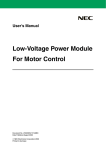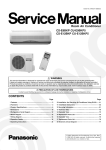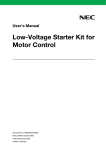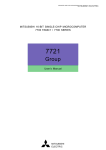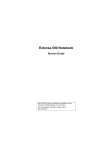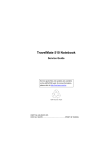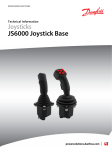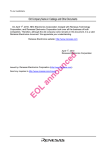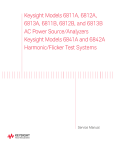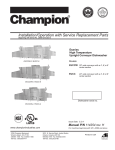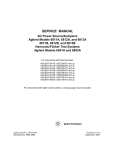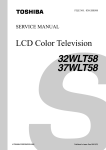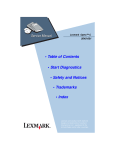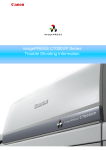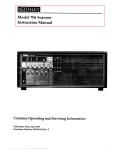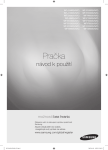Download MC-CPU-78F0714 Micro-Board for
Transcript
User’s Manual MC-CPU-78F0714 Micro-Board for µPD78F0714 Microcontroller for use with Motor Control I/O Interface Board Document No. U17707EU1V1UME0 Date Published August 2006 © NEC Electronics Corporation 2006 Printed in Germany CAUTION This is a Test- and Measurement equipment with possibility to be significantly altered by user through hardware enhancements/modifications and/or test or application software. Thus, with respect to Council Directive 89/336/EEC (Directive on compliance with the EMC protection requirements), this equipment has no autonomous function. Consequently this equipment is not marked by the CE-symbol. EEDT-ST-0005-10 Redemption of Waste Electrical and Electronic Equipment (WEEE) in accordance with legal regulations applicable in the European Union only: This equipment (including all accessories) is not intended for household use. After use the equipment cannot be disposed of as household waste. NEC Electronics (Europe) GmbH offers to take back the equipment. All you need to do is register at www.eu.necel.com/weee. All (other) product, brand, or trade names used in this pamphlet are the trademarks or registered trademarks of their respective owners. Product specifications are subject to change without notice. To ensure that you have the latest product data, please contact your local NEC Electronics sales office. 2 User’s Manual U17707EU1V1UME0 NOTES FOR CMOS DEVICES 1 VOLTAGE APPLICATION WAVEFORM AT INPUT PIN Waveform distortion due to input noise or a reflected wave may cause malfunction. If the input of the CMOS device stays in the area between VIL (MAX) and VIH (MIN) due to noise, etc., the device may malfunction. Take care to prevent chattering noise from entering the device when the input level is fixed, and also in the transition period when the input level passes through the area between VIL (MAX) and VIH (MIN). 2 HANDLING OF UNUSED INPUT PINS Unconnected CMOS device inputs can be cause of malfunction. If an input pin is unconnected, it is possible that an internal input level may be generated due to noise, etc., causing malfunction. CMOS devices behave differently than Bipolar or NMOS devices. Input levels of CMOS devices must be fixed high or low by using pull-up or pull-down circuitry. Each unused pin should be connected to VDD or GND via a resistor if there is a possibility that it will be an output pin. All handling related to unused pins must be judged separately for each device and according to related specifications governing the device. 3 PRECAUTION AGAINST ESD A strong electric field, when exposed to a MOS device, can cause destruction of the gate oxide and ultimately degrade the device operation. Steps must be taken to stop generation of static electricity as much as possible, and quickly dissipate it when it has occurred. Environmental control must be adequate. When it is dry, a humidifier should be used. It is recommended to avoid using insulators that easily build up static electricity. Semiconductor devices must be stored and transported in an anti-static container, static shielding bag or conductive material. All test and measurement tools including work benches and floors should be grounded. The operator should be grounded using a wrist strap. Semiconductor devices must not be touched with bare hands. Similar precautions need to be taken for PW boards with mounted semiconductor devices. 4 STATUS BEFORE INITIALIZATION Power-on does not necessarily define the initial status of a MOS device. Immediately after the power source is turned ON, devices with reset functions have not yet been initialized. Hence, power-on does not guarantee output pin levels, I/O settings or contents of registers. A device is not initialized until the reset signal is received. A reset operation must be executed immediately after power-on for devices with reset functions. 5 POWER ON/OFF SEQUENCE In the case of a device that uses different power supplies for the internal operation and external interface, as a rule, switch on the external power supply after switching on the internal power supply. When switching the power supply off, as a rule, switch off the external power supply and then the internal power supply. Use of the reverse power on/off sequences may result in the application of an overvoltage to the internal elements of the device, causing malfunction and degradation of internal elements due to the passage of an abnormal current. The correct power on/off sequence must be judged separately for each device and according to related specifications governing the device. 6 INPUT OF SIGNAL DURING POWER OFF STATE Do not input signals or an I/O pull-up power supply while the device is not powered. The current injection that results from input of such a signal or I/O pull-up power supply may cause malfunction and the abnormal current that passes in the device at this time may cause degradation of internal elements. Input of signals during the power off state must be judged separately for each device and according to related specifications governing the device. User’s Manual U17707EU1V1UME0 3 • The information in this document is current as of August, 2006. The information is subject to change without notice. For actual design-in, refer to the latest publications of NEC Electronics data sheets or data books, etc., for the most up-to-date specifications of NEC Electronics products. Not all products and/or types are available in every country. Please check with an NEC Electronics sales representative for availability and additional information. • No part of this document may be copied or reproduced in any form or by any means without the prior written consent of NEC Electronics. NEC Electronics assumes no responsibility for any errors that may appear in this document. • NEC Electronics does not assume any liability for infringement of patents, copyrights or other intellectual property rights of third parties by or arising from the use of NEC Electronics products listed in this document or any other liability arising from the use of such products. No license, express, implied or otherwise, is granted under any patents, copyrights or other intellectual property rights of NEC Electronics or others. • Descriptions of circuits, software and other related information in this document are provided for illustrative purposes in semiconductor product operation and application examples. The incorporation of these circuits, software and information in the design of a customer's equipment shall be done under the full responsibility of the customer. NEC Electronics assumes no responsibility for any losses incurred by customers or third parties arising from the use of these circuits, software and information. • While NEC Electronics endeavors to enhance the quality, reliability and safety of NEC Electronics products, customers agree and acknowledge that the possibility of defects thereof cannot be eliminated entirely. To minimize risks of damage to property or injury (including death) to persons arising from defects in NEC Electronics products, customers must incorporate sufficient safety measures in their design, such as redundancy, fire-containment and anti-failure features. • NEC Electronics products are classified into the following three quality grades: "Standard", "Special" and "Specific". The "Specific" quality grade applies only to NEC Electronics products developed based on a customerdesignated "quality assurance program" for a specific application. The recommended applications of an NEC Electronics product depend on its quality grade, as indicated below. Customers must check the quality grade of each NEC Electronics product before using it in a particular application. "Standard": Computers, office equipment, communications equipment, test and measurement equipment, audio and visual equipment, home electronic appliances, machine tools, personal electronic equipment and industrial robots. "Special": Transportation equipment (automobiles, trains, ships, etc.), traffic control systems, anti-disaster systems, anti-crime systems, safety equipment and medical equipment (not specifically designed for life support). "Specific": Aircraft, aerospace equipment, submersible repeaters, nuclear reactor control systems, life support systems and medical equipment for life support, etc. The quality grade of NEC Electronics products is "Standard" unless otherwise expressly specified in NEC Electronics data sheets or data books, etc. If customers wish to use NEC Electronics products in applications not intended by NEC Electronics, they must contact an NEC Electronics sales representative in advance to determine NEC Electronics' willingness to support a given application. (Note) (1) "NEC Electronics" as used in this statement means NEC Electronics Corporation and also includes its majority-owned subsidiaries. (2) "NEC Electronics products" means any product developed or manufactured by or for NEC Electronics (as defined above). M8E 02. 11-1 4 User’s Manual U17707EU1V1UME0 For further information, please contact: NEC Electronics Corporation 1753, Shimonumabe, Nakahara-ku, Kawasaki, Kanagawa 211-8668, Japan Tel: 044-435-5111 http://www.necel.com/ [America] [Europe] [Asia & Oceania] NEC Electronics America, Inc. 2880 Scott Blvd. Santa Clara, CA 95050-2554, U.S.A. Tel: 408-588-6000 800-366-9782 http://www.am.necel.com/ NEC Electronics (Europe) GmbH Arcadiastrasse 10 40472 Düsseldorf, Germany Tel: 0211-65030 http://www.eu.necel.com/ NEC Electronics (China) Co., Ltd 7th Floor, Quantum Plaza, No. 27 ZhiChunLu Haidian District, Beijing 100083, P.R.China Tel: 010-8235-1155 http://www.cn.necel.com/ Hanover Office Podbielskistrasse 166 B 30177 Hannover Tel: 0 511 33 40 2-0 Munich Office Werner-Eckert-Strasse 9 81829 München Tel: 0 89 92 10 03-0 Stuttgart Office Industriestrasse 3 70565 Stuttgart Tel: 0 711 99 01 0-0 United Kingdom Branch Cygnus House, Sunrise Parkway Linford Wood, Milton Keynes MK14 6NP, U.K. Tel: 01908-691-133 Succursale Française 9, rue Paul Dautier, B.P. 52180 78142 Velizy-Villacoublay Cédex France Tel: 01-3067-5800 Sucursal en España Juan Esplandiu, 15 28007 Madrid, Spain Tel: 091-504-2787 NEC Electronics Shanghai Ltd. Room 2509-2510, Bank of China Tower, 200 Yincheng Road Central, Pudong New Area, Shanghai P.R. China P.C:200120 Tel: 021-5888-5400 http://www.cn.necel.com/ NEC Electronics Hong Kong Ltd. 12/F., Cityplaza 4, 12 Taikoo Wan Road, Hong Kong Tel: 2886-9318 http://www.hk.necel.com/ Seoul Branch 11F., Samik Lavied’or Bldg., 720-2, Yeoksam-Dong, Kangnam-Ku, Seoul, 135-080, Korea Tel: 02-558-3737 NEC Electronics Taiwan Ltd. 7F, No. 363 Fu Shing North Road Taipei, Taiwan, R. O. C. Tel: 02-8175-9600 http://www.tw.necel.com/ NEC Electronics Singapore Pte. Ltd. 238A Thomson Road, #12-08 Novena Square, Singapore 307684 Tel: 6253-8311 http://www.sg.necel.com/ Tyskland Filial Täby Centrum Entrance S (7th floor) 18322 Täby, Sweden Tel: 08 638 72 00 Filiale Italiana Via Fabio Filzi, 25/A 20124 Milano, Italy Tel: 02-667541 Branch The Netherlands Steijgerweg 6 5616 HS Eindhoven The Netherlands Tel: 040 265 40 10 G06.8A User’s Manual U17707EU1V1UME0 5 [MEMO] 6 User’s Manual U17707EU1V1UME0 Preface Readers This manual is intented for users who want to understand the functions of the MC-CPU-78F0714 Micro-Board for µPD78F0714 Microcontroller for use with Motor Control I/O Interface Board. Purpose This manual presents the hardware manual of the MC-CPU-78F0714 Micro-Board for µPD78F0714 Microcontroller for use with Motor Control I/O Interface Board. Organization This system specification describes the following sections: Legend • System specifications • Hardware features • On-board components Symbols and notation are used as follows: Weight in data notation : Left is high-order column, right is low order column Active low notation : xxx (pin or signal name is over-scored) or /xxx (slash before signal name) Memory map address: : High order at high stage and low order at low stage Note : Explanation of (Note) in the text Caution : Item deserving extra attention Remark : Supplementary explanation to the text Numeric notation : Binary... XXXX or XXXB Decimal... XXXX Hexadecimal... XXXXH or 0x XXXX Prefixes representing powers of 2 (address space, memory capacity) K (kilo): 210 = 1024 M (mega): 220 = 10242 = 1,048,576 G (giga): 230 = 10243 = 1,073,741,824 User’s Manual U17707EU1V1UME0 7 8 User’s Manual U17707EU1V1UME0 Table of Contents Preface . . . . . . . . . . . . . . . . . . . . . . . . . . . . . . . . . . . . . . . . . . . . . . . . . . . . . . . 7 Chapter 1 Chapter 2 2.1 2.2 Chapter 3 Introduction. . . . . . . . . . . . . . . . . . . . . . . . . . . . . . . . . . . . . . . . . . . . . . . . . . . 15 System Specifications . . . . . . . . . . . . . . . . . . . . . . . . . . . . . . . . . . . . . . . . . . 16 Specifications of the µPD78F0714 Microcontroller . . . . . . . . . . . . . . . . . . . . . . . . . . 16 Specifications of the MC-CPU-78F0714 Micro-Board . . . . . . . . . . . . . . . . . . . . . . . . . 16 Hardware Features . . . . . . . . . . . . . . . . . . . . . . . . . . . . . . . . . . . . . . . . . . . . . 17 3.1 Operating Modes . . . . . . . . . . . . . . . . . . . . . . . . . . . . . . . . . . . . . . . . . . . . . . . . . . . . . . 18 3.1.1 Demonstration configuration . . . . . . . . . . . . . . . . . . . . . . . . . . . . . . . . . . . . . . . 18 3.1.2 Debugging configuration . . . . . . . . . . . . . . . . . . . . . . . . . . . . . . . . . . . . . . . . . . 18 3.2 Power Supply . . . . . . . . . . . . . . . . . . . . . . . . . . . . . . . . . . . . . . . . . . . . . . . . . . . . . . . . . 19 3.3 Reprogramming the MCU’s Flash Memory . . . . . . . . . . . . . . . . . . . . . . . . . . . . . . . . . 19 3.4 Measuring Power Consumption of the µPD78F0714 . . . . . . . . . . . . . . . . . . . . . . . . . 19 Chapter 4 On-Board Components . . . . . . . . . . . . . . . . . . . . . . . . . . . . . . . . . . . . . . . . . 20 4.1 4.2 4.3 4.4 4.5 4.6 4.7 4.8 4.9 4.10 4.11 4.12 2J2: 16-Pin Flash Programming Interface Header . . . . . . . . . . . . . . . . . . . . . . . . . . . 20 SBx Array: Flash Interface Signal Selection . . . . . . . . . . . . . . . . . . . . . . . . . . . . . . . . 21 2JP6: VDD_KX Selection . . . . . . . . . . . . . . . . . . . . . . . . . . . . . . . . . . . . . . . . . . . . . . . . 22 2JP5: Main Clock Selection Jumper . . . . . . . . . . . . . . . . . . . . . . . . . . . . . . . . . . . . . . 22 Subclock Selection . . . . . . . . . . . . . . . . . . . . . . . . . . . . . . . . . . . . . . . . . . . . . . . . . . . . 23 1J1: µPD78F0714 I/O Pin Array. . . . . . . . . . . . . . . . . . . . . . . . . . . . . . . . . . . . . . . . . . . 23 2SW1 Push Button Switch . . . . . . . . . . . . . . . . . . . . . . . . . . . . . . . . . . . . . . . . . . . . . . 24 2JP11: FLMD0 Connection for Flash Self-Programming Mode . . . . . . . . . . . . . . . . . 24 2JP12: FLMD01 Connection for Flash Self-Programming Mode . . . . . . . . . . . . . . . . 24 Solder Blob Selection . . . . . . . . . . . . . . . . . . . . . . . . . . . . . . . . . . . . . . . . . . . . . . . . . . 24 2JP7: QB-78K0MINI ICE Connector . . . . . . . . . . . . . . . . . . . . . . . . . . . . . . . . . . . . . . . 26 2P1 and 2P2: 100-Pin Connectors . . . . . . . . . . . . . . . . . . . . . . . . . . . . . . . . . . . . . . . . 26 User’s Manual U17707EU1V1UME0 9 10 User’s Manual U17707EU1V1UME0 List of Figures Figure 1-1: Figure 3-1: Figure 4-1: Figure 4-2: Figure 4-3: Figure 4-4: Figure 4-5: Figure 4-6: Figure 4-7: MC-CPU-78F0714 Micro-Board .................................................................................. 15 MC-CPU-78F0714 Micro-Board Layout ..................................................................... 17 Signal Assignments for 16-Pin Debugging and Flash Programming Interface Connector ............................................................ 20 SBx Array .................................................................................................................... 21 2JP6 Configuration ...................................................................................................... 22 2JP5 Jumper ............................................................................................................... 22 I/O Pin Array ................................................................................................................ 23 Solder Blob Pads......................................................................................................... 24 Micro-Board Connection to the MINICUBE ................................................................. 26 User’s Manual U17707EU1V1UME0 11 12 User’s Manual U17707EU1V1UME0 List of Tables Table 3-1: Table 3-2: Table 4-1: Table 4-2: Table 4-3: Table 4-4: Table 4-5: Table 4-6: Default Jumper Settings ................................................................................................. 18 2JP1: Current Measurement Terminal ........................................................................... 19 Flash Programming Signal Descriptions ........................................................................ 21 2JP6 Settings ................................................................................................................. 22 2JP5 Settings ................................................................................................................. 23 SBx Connections ............................................................................................................ 25 2P1 Connector Pin Assignments.................................................................................... 27 J2 Connector Assignments............................................................................................. 30 User’s Manual U17707EU1V1UME0 13 14 User’s Manual U17707EU1V1UME0 Chapter 1 Introduction The MC-CPU-78F0714 micro-board is designed to demonstrate and evaluate the CPU and on-chip peripheral functions of the NEC Electronics 8-bit µPD78F0714 microcontroller (MCU). The micro-board can be operated in stand-alone mode to evaluate the main features of the MCU or it can be connected through two 100-pin connectors to a separately sold motor control interface board (MC-IO) to evaluate the MCU’s dedicated 3-phase motor control peripherals. The micro-board also may be used with a lowcost evaluation system called the M-Station (sold in the U.S. only), but this manual only describes configuration and operation of the MC-CPU-78F0714 when used with the MC-IO board. Figure 1-1: MC-CPU-78F0714 Micro-Board Top View Bottom View User’s Manual U17707EU1V1UME0 15 Chapter 2 System Specifications 2.1 Specifications of the µPD78F0714 Microcontroller • Flash program memory of 32 KB • High-speed data RAM of 1 KB • Forty-eight I/O ports: 40 CMOS input/output (I/O) pins and eight CMOS inputs • Eight-channel, 10-bit analog-to-digital (A/D) converter • Serial interfaces - One-channel universal asynchronous receiver/transmitter (UART) - One-channel, 3-wire serial I/O • Timers - One-channel, 10-bit inverter control timer - One-channel, 16-bit up/down counter for motor encoder interfacing - One-channel, 16-bit timer/event counter - One-channel, 8-bit timer/event counter - Two-channel, 8-bit timer - One-channel watchdog timer • Eleven timer outputs (with six inverter control outputs for motor driving) • Twenty vectored interrupts • Eight external interrupts • 4.0–5.5 VDC power supply voltage • 64-pin, 12 × 12 mm TQFP (µPD78F0714GK-9ET) • Reference: µPD78F0714 User's Manual (U16928EJ1V0UD00) 2.2 Specifications of the MC-CPU-78F0714 Micro-Board • On-board 20 MHz main clock • MCU I/O port connector that provides all I/O pins of the µPD78F0714 • 16-pin debugging and flash programming interface connector • 10-pin QB-78K0MINI on-chip debugging interface connector • Board size of 3.5 × 2 inches (W × L) 16 User’s Manual U17707EU1V1UME0 Chapter 3 Hardware Features Figure 3-1: MC-CPU-78F0714 Micro-Board Layout User’s Manual U17707EU1V1UME0 17 Chapter 3 Table 3-1: Hardware Features Default Jumper Settings Jumper Setting Function Description 2JP1 1–2 VDD_KX-VDD µD78F0714 VDD is derived from VDD_KX 2JP5 2–6 3–5 X1/X2 select Must be selected as a pair Selects X1 and X2 from on-board oscillator 2JP6 2–3 VDD_KX – 2TPEXTVDD1 Supplies external VDD 2JP8 2–3 INTP1_PX to P01 Sensor input to P01/INTP1 2JP9 2–3 INTP2_PY to P02 Sensor input to P02/INTP2 2JP10 2–3 INTP3_PZ to P03 Sensor input to P03/INTP3 2JP7 Open 2JP11 Open 2JP12 Open 3.1 Operating Modes 3.1.1 Demonstration configuration In standalone mode, the MC-CPU-78F0714 micro-board can be used to execute programs loaded into the MCU’s on-chip flash memory for the purpose of evaluating the CPU and its on-chip peripheral functions. To configure for standalone operation, attach the MC-CPU-78F0714 micro-board to the MC-IO board through the two 100-pin connectors. By default, the MC-CPU-78F0714 micro-board is configured to operate in this mode, as shown in Default Jumper Settings . 3.1.2 Debugging configuration To debug a user program, connect the MC-CPU-78F0714 micro-board to the separately sold 78K0MINI in-circuit emulator (ICE) using the 2JP7 on-chip debugging connector. In debugging mode, the 78K0MINI ICE supplies the clock to the CPU through that connector. Also disconnect the on-board, 20MHz crystal oscillator by removing the jumpers on the 2JP5 headers. Alternatively the MC-CPU-78F0714 board can be debugged using the 78K0 IECUBE full-function ICE. Contact your NEC Electronics representative for additional information. 18 User’s Manual U17707EU1V1UME0 Chapter 3 Hardware Features 3.2 Power Supply When pins 1 and 2 of 2JP6 are connected, the MC-IO board supplies 5VDC to the MC-CPU-78F0714 micro-board through the two 100-pin connectors. To use an external power source, connect pins 2 and 3 of 2JP6 with a jumper block and connect the power source (5VDC max.) to 2TP_EXTVDD1 and 2TP_GND1. 3.3 Reprogramming the MCU’s Flash Memory The on-chip flash memory can be reprogrammed at any time. To reprogram the on-chip flash memory, a dedicated flash programmer such as the PG-FP4-E (sold separately) can be used when connected to 2J2 16-pin header terminal. When the 78K0MINI ICE is used for debugging and the code is downloaded, the flash memory will retain the program. 3.4 Measuring Power Consumption of the µPD78F0714 The power select jumper, 2JP1, is designed to connect an ampere meter to measure accurate power consumption for the µPD78F0714, regardless of which power source is selected. To measure power consumption for the µPD78F0714: 1. Remove the power select jumper on 2JP1. 2. Connect an ampere meter on the 2JP1 terminals. Table 3-2: Setting 2JP1: Current Measurement Terminal Selected Power Source 1 to 2 Connect with jumper: VDD_KX to VDD 1 to 2 Connect with ampere meter: CPU current measurement Caution: Status Default 2JP1 is a dedicated terminal connected to the VDD pin of the µPD78F0714 so that MCU power consumption can be measured accurately. Therefore, the MC-CPU78F0714 micro-board can remain connected to the MC-IO board during power measurement. User’s Manual U17707EU1V1UME0 19 Chapter 4 On-Board Components 4.1 2J2: 16-Pin Flash Programming Interface Header The 16-pin header provides flash programming Interface for the MC-CPU-78F0714. To program the flash, the NEC Electronics flash programmer such as the PG-FP4-E can be used. For instructions on how to program the flash, refer to the PG-FP4-E User's Manual. Note: The 16-pin flash programming interface header can also be used for debugging the program running on the MC-CPU-78F0714 using the M-Station that is sold in the U.S. only. Some of the pin names shown in Figure 2 are dedicated for the M-Station interface. This manual only lists the interface signals for the PG-FP4-E flash programmer. Figure 4-1: Signal Assignments for 16-Pin Debugging and Flash Programming Interface Connector 2J2 20 GND 1 2 RESET_B1 RXD_SI 3 4 VDD_FLASH TXD_SO 5 6 VPP SCK 7 8 HS X1_OSC 9 10 VDE VDD2 11 12 FLMD1 USB_INTP 13 14 FLMD0 OPEN 15 16 RESET_B2 User’s Manual U17707EU1V1UME0 Chapter 4 Table 4-1: Pin No. On-Board Components Flash Programming Signal Descriptions MC-CPU-78F0714 PG-FP4-E Flash Programmer 1 GND GND 2 RESET_B1 Reset to MC-CPU-78F0714 3 RXD_SI Serial I/O or UART data receive 4 VDD_FLASH VDD from Flash programmer 5 TXD_SO Serial I/O or UART data transmit 6 VPP Not Used 7 SCK SCK 8 HS Handshake 9 X1_OSC Clock to MC-CPU-78F0714 10 VDE VDD 11 VDD2 Not Used 12 FLMD1 Not Used 13 USB_INTP Not Used 14 FLMD0 FLMD0 15 OPEN 16 RESET_B2 Not Used 4.2 SBx Array: Flash Interface Signal Selection The SBx array (solder blobs) is used to connect the flash programming interface signals on the 16-pin 2J2 header to appropriate pins of the µPD78F0714. The default settings shown in SBx Array are configured for flash programming. Figure 4-2: VDE RXD_SI SBx Array 2SB10 VDD_Kx 2SB12 P14/TXD00 (pin 37) 2SB13 P17/SO10 (pin 40) TXD_SO 2SB16 P13/RXD00 (pin 36) 2SB17 P16/SO0 (pin 39) SCK HS 2SB19 P15/SCK10 (pin 38) 2SB21 P64 (pin 49) Default connection User’s Manual U17707EU1V1UME0 21 Chapter 4 On-Board Components 4.3 2JP6: VDD_KX Selection The MC-CPU-78F0714 micro board can derive power from two sources: EXT_VDD, a user-supplied external power source between 4.0–5.5 VDC or VDD_FLASH, a power source derived from the MC-IO board’s two 100-pin connectors, 2P1 and 2P2. Figure 4-3: 2JP6 Configuration 2JP6 1 VDD_FLASH 2 VDD_KX EXT_VDD 3 Table 4-2: Setting 2JP6 Settings Selected Power Source Status 1 to 2 Select VDD_FLASH from MC-IO board Default 2 to 3 Select EXT_VDD from user's target system 4.4 2JP5: Main Clock Selection Jumper A 20 MHz crystal oscillator (2Y2) is mounted on the MC-CPU-78F0714 micro-board as the main clock. If desired, it can be removed and replaced by a different model. A Citizen HC49US Series quartz crystal oscillator that uses 18-picofarad (pF) biasing capacitors for a range of frequencies is recommended. The X1 and X2 pins of the µPD78F0714 are also connected to the I/O pin array, and may be driven by external connection to the appropriate pins of the I/O pin array. In this case, all pins of 2JP5 should be left open. The 2JP5 should be left open when using the 10-pin connector, 2JP7, connecting to the on-chip debugging emulator, such as QB-78K0MINI. Figure 4-4: 2JP5 Jumper 2JP5 X1_OSC X1 X2 X2_OSC 1 2Y2 (20 MHz - Osc.) HC49US20.000MABJ 2 6 3 5 4 2Y2 18 pF 18 pF GND 22 GND User’s Manual U17707EU1V1UME0 Chapter 4 On-Board Components Table 4-3: Setting 2JP5 Settings Selected Main Clock Source X1 Clock 2 to 6 3 to 5 Select X2 from MC-CPU-78F0714 micro-board Select X1 from MC-CPU-78F0714 micro-board X1 = 20 MHz Must be selected as a pair 1 to 2 Select X1_OSC from MC-IO board Note Open When using OCD connector 2JP7 Open When using clock from 2J1on the target system Status Default Note: For a driven clock, X1_OSC (X1_OSC from the MC-IO board connector 2P1) can be connected to X1 by inserting a jumper on pin 1 to pin 2 while X2_OSC is open. Refer to the µPD78F0714 User's Manual for information about configuring a driven clock for X1 and X2. 4.5 Subclock Selection The subclock is not supported for the µPD78F0714. 4.6 1J1: µPD78F0714 I/O Pin Array 1J1 is a pin array connecting the µPD78F0714 I/O pins. It is an optional array for mounting the microboard directly onto your target system, or for allowing easy access to all I/O pins. 1J1 is divided into four groups of 16 pins around the MCU. Figure 4-5: I/O Pin Array µPD70F0714 Mounted Underside Pin 17 through Pin 32 Pin 49 through Pin 64 Pin 1 through Pin 16 Pin 33 through Pin 32 User’s Manual U17707EU1V1UME0 23 Chapter 4 On-Board Components 4.7 2SW1 Push Button Switch 2SW1 is a push button switch. Pressing 2SW1 connects the MCU’s RESET pin to GND and resets the MCU. 4.8 2JP11: FLMD0 Connection for Flash Self-Programming Mode Setting Selected Power Source 1 to 2 Open: normal operation 1 to 2 Connect: P10 is used to drive FLMD0 for flash programming mode Status Default 4.9 2JP12: FLMD01 Connection for Flash Self-Programming Mode Setting Selected Power Source 1 to 2 Open: normal operation 1 to 2 Connect: P11 is used to drive FLMD1 for flash programming mode Status Default 4.10 Solder Blob Selection Several signals of the µPD78F0714 are connected to a solder blob, designated as SB× on the microboard. The solder blob is formed with two pads, making it easier to connect or disconnect with a blob of solder. Figure 4-6: Solder Blob Pads SBx 24 User’s Manual U17707EU1V1UME0 Chapter 4 On-Board Components Table 4-4: Connector SBx Connections Description Default 2SB1–2SB8 Optional connection for P2[7:0] termination with 1MΩ to GND Connected 2SB22 Optional connection for EVDD to VDD Connected 2SB23 Optional connection for AVREF to VDD Connected 2SB10 Optional connection for VDE to VDD_KX Connected 2SB11 Optional connection for host computer interrupt to P00/INTP0 Open 2SB12 Optional connection for RXD_SI to P14/TXD00 Connected 2SB13 Optional connection for RXD_SI to P17/SO10 Open 2SB16 Optional connection for TXD_SO to P13/RXD00 Connected 2SB17 Optional connection for TXD_SO to P16/SI10 Open 2SB19 Optional connection for SCK to P15/SCK10_B Open 2SB21 Optional connection for HS (handshake) to P64 Open 2SB24 Optional connection for RESET_QB to RESET_KX Open (note 1) 2SB25 Optional connection for X2_QB to P32 Open (note 2) 2SB26 Optional connection for X2_QB to X2 Connected (note 2) 2SB27 Optional connection for X1_QB to X1 Connected (note 3) 2SB28 Optional connection for X1_QB to P31 Open (note 3) 2SB29 Optional connection for INTP1_PX for speed measure Connected (note 4) 2SB30 Optional connection for INTP2_PY for speed measure Open (note 4) 2SB31 Optional connection for INTP3_PZ for speed measure Open (note 4) Notes: 1. SBx optional connections when using QB-78K0MINI ICE (refer to document no. U17029EJ2V0UM00) - When QB-78K0MINI is used, the QB-78K0MINI in-circuit emulator (ICE) handles the RESET connection. - When QB-78K0MINI is not used, connect 2JP7.1 to 2JP7.2 (10-pin header) with a shorting jumper. - 22SB24 can be used to permanently connect RESETB_KX to RESETB_QB. 2. X2_QB: X2_QB is a single-wire, bi-directional data input that can be X2 or P32 (refer to the QB-78K0MINI User's Manual). - 2SB25 connects X2_QB to P32. - 2SB26 connects X2_QB to X2 (factory default). 3. X1_QB: X1_QB can be X1 or P31. - 2SB27 connects X1_QB to X1. - 2SB28 connects X1_QB to P31. 4. Motor speed measurement input - INTP1_PX, INTP2_PY or INTP3_PZ are signals from motor control I/O board. - These are the signals providing sensor (HALL or back-EMF detection) inputs. - The selected INTP_x signal is input to P53/TI000 (capture/compare register) of the on-chip timer for speed measurement. User’s Manual U17707EU1V1UME0 25 Chapter 4 On-Board Components 4.11 2JP7: QB-78K0MINI ICE Connector 2JP7 is provided for connection to the QB-78K0MINI ICE. When QB-78K0MINI is connected, the MINICUBE controls the MCU’s RESET line. When QB-78K0MINI is not connected, pins 1 and 2 of 2JP7 should be shorted to control the RESET from the on-board 2SW1 push button or the MC-IO board’s push button through the 100-pin 2P2 target connector. To connect pins 1 and 2 on 2JP7, it is recommended to use a jumper block instead of SBx. Figure 4-7: Micro-Board Connection to the MINICUBE SBx 2JP7 RESETB_QB FLMD0_KX X2_QB X1_QB OPEN 1 2 3 4 5 6 7 8 9 10 RESETB_KX VDD_KX GND GND OPEN 4.12 2P1 and 2P2: 100-Pin Connectors Two 100-pin connectors are used to connect all µPD78F0714 signals to the MC-IO board. The µPD78F0714 signals are arranged so that selected signals connect to the motor control function signals on the MC-IO board, while the others can be used for prototyping. All signals are connected to preassigned positions of the 2P1 and 2P2 connectors. The mating connector for the 100-pin connectors is a 0.6-millimeter (mm), single-row surface-mount technology type (Hirose FX8-Series, part number FX8C-100P-SV6). Tables 8 and 9 show the pin assignments of the MCU to the 100-pin 2P1 and 2P2 connectors that correspond to the MC-IO board’s 100-pin J1 and J2 connectors. 26 User’s Manual U17707EU1V1UME0 Chapter 4 Table 4-5: On-Board Components 2P1 Connector Pin Assignments (1/3) MC-78F0714 Micro-Board 2P1 Pin Number MC-IO Board CPU Pin Number Pin Name J1 Pin Number Motor Control Function Pin Name 1 1 GND_IS CPU ground 2 2 GND_IS CPU ground 3 P13/RXD00 36 3 RS232_RXD RS232 transceiver TXD output 4 P10 33 4 RS232_CTS RS232 transceiver CTS output 5 P14/TXD00 37 5 RS232_TXD RS232 transceiver RXD input 6 P11 34 6 RS232_RTS RS232 transceiver RTS output 7 P64 49 7 J1007 N/A 8 P65 50 8 J1008 N/A 9 P27/ANI7 57 9 J1009 Power Module temperature 10 J1010 10 11 P00/INTP0/TW0TOFFP 12 11 P00_ITRIP Over- current detection 12 P01/INTP1 11 12 J1012 Hall1/BEMF1 detect (from 2JP8) 13 P02/INTP2 10 13 J1013 Hall2/BEMF detect (from 2JP9) 14 P03/INTP3 9 14 J1014 Hall3/BEMF detect (from 2JP10) 15 15 J1015 16 16 J1016 17 17 J1017 18 18 J1018 19 P20/ANI0 64 19 J1019 Phase-U current 20 P21/ANI1 63 20 J1020 Phase-V current 21 P22/ANI2 62 21 J1021 Phase-W current 22 P23/ANI3 61 22 J1022 Motor temperature 23 P24/ANI4 60 23 J1023 Speed potentiometer 24 P25/ANI5 59 24 ANI5_ISHUNT Common current shunt 25 P26/ANI6 58 25 J1025 Spare analogue 26 P27/ANI7 57 26 J1026 Power module temperature 27 P50 17 27 J1027 N/A 28 P51 18 28 J1028 N/A 29 P52/INTP4 19 29 J1029 N/A 30 P53/INTP5 20 30 J1030 N/A 31 P54 21 31 P54_TRIPB Power module shut-down 32 P55/INTP6 22 32 J1032 N/A 33 P56/INTP7 23 33 J1033 N/A 34 P57 24 34 J1034 N/A 35 P40 41 35 J1035 N/A 36 P41 42 36 J1036 N/A 37 P42 43 37 J1037 N/A 38 P43 44 38 J1038 N/A User’s Manual U17707EU1V1UME0 27 Chapter 4 Table 4-5: On-Board Components 2P1 Connector Pin Assignments (2/3) MC-78F0714 Micro-Board 2P1 Pin Number 28 Pin Name MC-IO Board CPU Pin Number J1 Pin Number Motor Control Function Pin Name 39 P44 45 39 J1039 N/A 40 P45 46 40 J1040 N/A 41 P46 47 41 J1041 N/A 42 P47 48 42 J1042 N/A 43 P10 33 43 J1043 N/A 44 P11 34 44 J1044 N/A 45 P12 35 45 J1045 N/A 46 P13/RXD00 36 46 J1046 N/A 47 P14/TXD00 37 47 J1047 N/A 48 P15/SCK10_B 38 48 J1048 N/A 49 P16/SI10 39 49 J1049 N/A 50 P17/FLMD1 40 50 J1050 N/A 51 51 J1.051 52 52 J1.052 53 53 J1.053 54 54 J1.054 55 P30/BUZZ 13 55 J1.055 N/A 56 P31/PCL 14 56 J1.056 N/A 57 P32 15 57 J1.057 N/A 58 P33 16 58 J1.058 N/A 59 P70 53 59 J1059 MODE push button 60 P71 54 60 J1060 REVERSE push button 61 P72 55 61 J1061 FORWARD push -button 62 P73 56 62 J1062 START/STOP push button 63 63 J1063 64 64 J1064 65 65 J1065 66 66 J1066 67 67 J1067 68 68 J1068 69 69 J1069 70 70 J1070 71 71 J1071 72 72 J1072 73 73 J1073 74 74 J1074 75 Not used 75 76 Not used 76 77 Not used 77 78 Not used 78 User’s Manual U17707EU1V1UME0 Chapter 4 Table 4-5: On-Board Components 2P1 Connector Pin Assignments (3/3) MC-78F0714 Micro-Board 2P1 Pin Number Pin Name MC-IO Board CPU Pin Number J1 Pin Number Pin Name Motor Control Function 79 Not used 79 80 Not used 80 81 Not used 81 82 Not used 82 83 Not used 83 84 Not used 84 85 Not used 85 86 Not used 86 87 Not used 87 88 Not used 88 89 Not used 89 90 Not used 90 91 Not used 91 92 Not used 92 93 Not used 93 94 Not used 94 95 Not used 95 96 Not used 96 97 Not used 97 98 Not used 98 99 VDD_FLASH 99 VCC_IS Flash programmer VDD 100 VCC_IS Flash programmer VDD 100 DD_FLASH User’s Manual U17707EU1V1UME0 29 Chapter 4 Table 4-6: On-Board Components J2 Connector Assignments (1/3) MC-78F0714 2P2 Pin Number 30 Pin Name MC-IO Board CPU Pin Number J2 Pin Number Pin Name Function 1 1 GND_IS CPU ground 2 2 GND_IS CPU ground 3 3 J2003 4 4 J2004 5 5 J2005 6 6 J2006 7 P66 51 7 J2007 N/A 8 P67 52 8 J2008 N/A 9 P26/ANI6 58 9 J2009 Spare analog 10 10 J2010 11 11 J2011 12 12 J2012 13 13 J2013 14 14 J2014 15 P64 49 15 LED0 I/O board: LED data latch 0 16 P65 50 16 LED1 I/O board: LED data latch 1 17 P66 51 17 LED2 I/O board: LED data latch 2 18 P67 52 18 LED3 I/O board: LED data latch 3 19 P40/RTP00 41 19 LED_A I/O board: LED segment A 20 P41/RTP01 42 20 LED_B I/O board: LED segment B 21 P42/RTP02 43 21 LED_C I/O board: LED segment C 22 P43/RTP03 44 22 LED_D I/O board: LED segment D 23 P44/RTP04 45 23 LED_E I/O board: LED segment E 24 P45/RTP05 46 24 LED_F I/O board: LED segment F 25 P46/RTP06 47 25 LED_G I/O board: LED segment G 26 P47/RTP07 48 26 LED_DP I/O board: LED decimal point 27 27 GND_IS CPU ground 28 28 GND_IS CPU ground 29 TW0TO0/RTP10 27 29 PWM_0 Phase U high 30 TW0TO1/RTP11 28 30 PWM_1 Phase U low 31 31 GND_IS CPU ground 32 32 GND_IS CPU ground 33 TW0TO2/RTP12 29 33 PWM_2 Phase V high 34 TW0TO3/RTP13 30 34 PWM_3 Phase V low 35 35 GND_IS CPU ground 36 36 GND_IS CPU ground 37 TW0TO4/RTP14 31 37 PWM_4 Phase W high 38 TW0TO5/RTP15 32 38 PWM_5 Phase W low User’s Manual U17707EU1V1UME0 Chapter 4 Table 4-6: On-Board Components J2 Connector Assignments (2/3) MC-78F0714 2P2 Pin Number MC-IO Board CPU Pin Number Pin Name J2 Pin Number Pin Name Function 39 39 GND_IS CPU ground 40 40 GND_IS CPU ground 41 SPD_MSR Speed measurement 42 GND_IS CPU ground 41 P53/INTP5/TI000 20 42 43 P26/ANI6 58 43 J2043 Spare analog 44 P27/ANI7 57 44 ANI7_TMP Motor temperature 45 45 GND_IS CPU ground 46 46 GND_IS CPU ground 47 47 INTP1_PX To Hall1/BEMF1 selector (2JP8) 48 48 INTP2_PY To Hall2/BEMF2 selector (2JP9) 49 49 GND_IS CPU ground 50 50 GND_IS CPU ground 51 51 INTP3_PZ To Hall3/BEMF3 selector (2JP10) 52 ANI0_IU Phase U current 53 53 GND_IS CPU ground 54 54 GND_IS CPU ground 52 P20/ANI0 64 55 P21/ANI1 63 55 ANI1_IV Phase V current 56 P22/ANI2 62 56 ANI2_IW Phase W current 57 57 GND_IS CPU ground 58 58 GND_IS CPU ground 59 P23/ANI3 61 59 ANI3_TEMP Power module temperature 60 P55/INTP6/TIT20IUD 22 60 PX_ENCA REVERSE push button 61 61 GND_IS CPU ground 62 62 GND_IS CPU ground 63 P56/INTP7/TIT20CUD/ TITCC0 23 63 PX_ENCB Motor shaft encoder 64 P57/TIT20CLR/TIT20CC1 24 64 PX_ENCZ Motor shaft encoder 65 65 GND_IS CPU ground 66 66 GND_IS CPU ground 67 P73 56 67 PX_START START/STOP push button 68 P72 55 68 PX_FORWA RD FORWARD push button 69 69 GND_IS CPU ground 70 70 GND_IS CPU ground 71 P71 54 71 PX_REVERS E REVERSE push button 72 P70 53 72 PX_MODE MODE push button 73 73 GND_IS CPU ground 74 74 GND_IS CPU ground 75 75 ANI4 Speed potentiometer 76 76 GND_IS CPU ground User’s Manual U17707EU1V1UME0 31 Chapter 4 Table 4-6: On-Board Components J2 Connector Assignments (3/3) MC-78F0714 2P2 Pin Number Pin Name MC-IO Board CPU Pin Number Pin Name 77 77 GND_IS 78 78 J2078 Function 79 VDD 4 79 VDD_KX External CPU VDD 80 EVDD 26 80 VDD1 CPU EVDD 81 J2081 82 AVREF CPU AVREF 83 83 AVDD CPU AVDD 84 84 J2084 81 82 AVREF 1 85 RESET_B 8 85 TG_RST CPU reset 86 FLMD0 3 86 VPP_FLMD0 CPU FLMD0 87 J2087 87 32 J2 Pin Number 88 X2 7 88 X2 CPU X2 89 X1 6 89 X1 CPU X1 90 90 J2090 91 91 J2091 92 92 J2092 93 93 J2093 94 94 J2094 95 95 J2095 96 96 J2096 97 97 J2097 98 98 J2098 99 99 VCC_IS Non-isolated power (+5V DC) 100 100 VCC_IS Non-isolated power (+5V DC) User’s Manual U17707EU1V1UME0


































